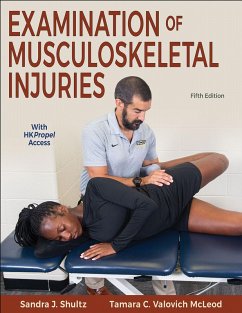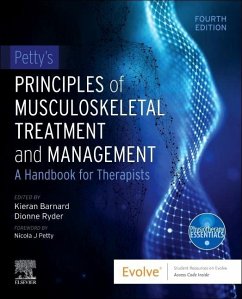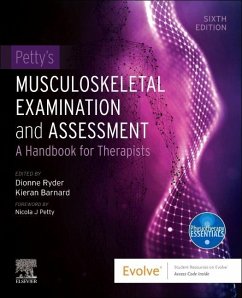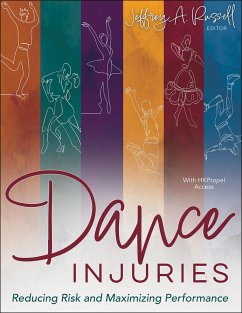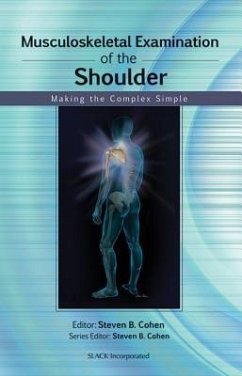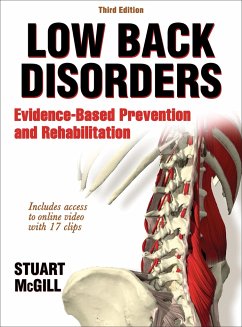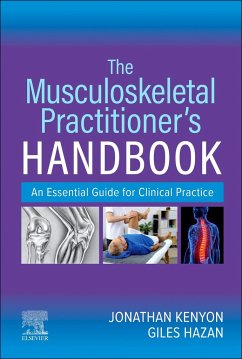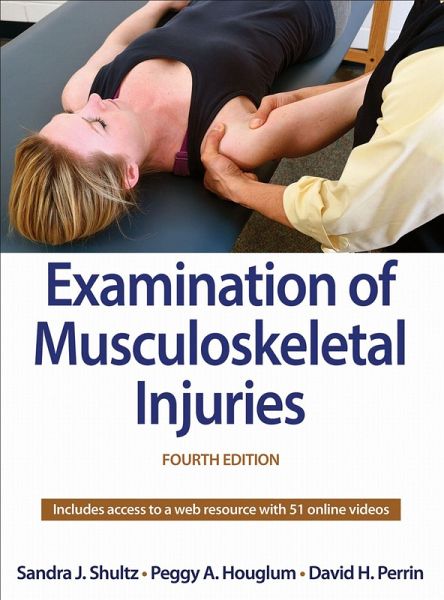
Examination of Musculoskeletal Injuries
Versandkostenfrei!
Versandfertig in 2-4 Wochen
Weitere Ausgaben:

PAYBACK Punkte
60 °P sammeln!




Examination of Musculoskeletal Injuries, Fourth Edition With Web Resource, guides current and future athletic trainers and rehabilitation professionals through the examination and evaluation of musculoskeletal injuries both on and off the field.
Sandra J. Shultz, PhD, ATC, CSCS, is professor and chair in the department of kinesiology at the University of North Carolina at Greensboro. As a certified athletic trainer since 1984, Shultz has a broad clinical perspective having worked with athletes at the high school, collegiate, Olympic, and international levels. Before coming to the University of North Carolina at Greensboro, Shultz taught and conducted clinical research in the sports medicine and athletic training program at the University of Virginia. She also served as associate director of athletic training and rehabilitative services at the University of California at Los Angeles, where two of her primary responsibilities were the direct health care of student-athletes and the education of athletic training students. Shultz is a member of the National Athletic Trainers' Association (NATA), the American College of Sports Medicine (ACSM), the National Strength and Conditioning Association (NSCA), and the Orthopaedic Research Society (ORS). She is a section editor for the Journal of Athletic Training. Previously she served on the NATA's Entry-Level Education Committee, Pronouncements Committee, Convention Educational Program Committee, Appropriate Medical Coverage for Intercollegiate Athletics Task Force, and Research and Education Foundation Research Committee. She was also a site visitor for the Joint Review Committee on Educational Programs in Athletic Training (JRC-AT). As a researcher, Shultz focuses on the study of risk factors for anterior cruciate ligament injury in female athletes and has received grant funding from the National Federation of State High School Associations (NFHS), the NATA Research and Education Foundation, the National Football League Medical Charities, and the National Institutes of Health. She is the primary author of the NFHS Sports Medicine Handbook and the NATA Appropriate Medical Care for Intercollegiate Athletics. Her awards from the NATA and NATA Foundation include the Freddie H. Fu, MD, New Investigator Award, the Most Distinguished Athletic Trainer Award, the Sayer "Bud" Miller Distinguished Educator Award, and the Medal for Distinguished Athletic Training Research.She was inducted into the NATA Hall of Fame. Shultz is a fellow of the NATA, the American College of Sports Medicine, and the National Academy of Kinesiology. Shultz enjoys running, reading, and traveling. She resides in Greensboro, North Carolina. Peggy A. Houglum, PhD, is retired as an associate professor at the Rangos School of Health Sciences at Duquesne University in Pittsburgh. She has nearly 45 years of experience providing patient and athlete care in a variety of settings, including athletic training facilities, sports medicine clinics, rehabilitation hospitals, acute care hospitals, burn care facilities, workers' compensation clinics, and extended care facilities. She has also been an athletic trainer with the United States Olympic Sports Festivals, Olympic Games, and World University Games. Houglum's extensive background as a certified athletic trainer, physical therapist, clinical and classroom educator, and program director gives her a unique perspective on the appropriate use of therapeutic exercise techniques in rehabilitation programs for treatment of athletic injuries. In 1991, Houglum created the NATA's first formal continuing educatiion programming. Since that time Houglum has been chair of the NATA Continuing Education Committee and a member of the organization's Education Council and the Council on Employment. She is a member of the NATA Hall of Fame and has received numerous awards, including the NATA's Most Distinguished Athletic Trainer, NATA Continuing Education Award, NATA Board of Directors Recognition for Outstanding Contributions, and Therapy Times Most Influential Rehabilitation Professional in Physical Therapy. Houglum is a member of the American Physical Therapy Association's Sports Medicine Section. She is also a member of NATA and serves on the NATA Board of Certification Role Delineation #7 Committee. Houglum is associate editor for Sports Rehabilitation and serves on the editorial board of Physical Therapy and Rehabilitation. Her professional writing career has focused on presenting complex concepts of health care to students at a level of understanding and appreciation that provides them with the conceptual and clinical core they need to become well-informed clinical professionals. She is author of Therapeutic Exercise for Musculoskeletal Injuries, lead author of Brunnstrom's Clinical Kinesiology, Sixth Edition, and book chapters on sports medicine and rehabilitation. Houglum enjoys spending time with family, reading, exercising, and painting. She resides in Cedar Grove, Wisconsin. David H. Perrin, PhD, ATC, is dean and professor of exercise and sport science in the College of Health at the University of Utah. For 13 years Perrin was a member of the NATA Professional Education Committee, helping to write the guidelines for accreditation of both undergraduate and graduate athletic training education programs. For 15 years he directed the graduate programs in athletic training and sports medicine in the Curry School of Education at the University of Virginia. He was editor in chief of the Journal of Athletic Training from 1996 to 2004 and was the founding editor of the Journal of Sport Rehabilitation. He is author of Isokinetic Exercise and Assessment and Athletic Taping and Bracing, editor of the third edition of The Injured Athlete, and coauthor of Research Methods in Athletic Training. Perrin's research interests include injury risk factors of the anterior cruciate ligament in female athletes. His awards from the National Athletic Trainers' Association include the Sayers "Bud" Miller Distinguished Educator Award, the Most Distinguished Athletic Trainer Award, and the William G. Clancy, Jr., MD, Medal for Distinguished Athletic Training Research. He was inducted into the NATA Hall of Fame. Perrin is a fellow of the National Athletic Trainers' Association, American College of Sports Medicine, and National Academy of Kinesiology. Perrin enjoys traveling, exercising, and vacationing at his lake cottage in Vermont.
Produktdetails
- Verlag: Human Kinetics Publishers
- Fourth Edition
- Seitenzahl: 688
- Erscheinungstermin: 10. November 2015
- Englisch
- Abmessung: 287mm x 222mm x 38mm
- Gewicht: 2152g
- ISBN-13: 9781450472920
- ISBN-10: 1450472923
- Artikelnr.: 42559849
Herstellerkennzeichnung
Libri GmbH
Europaallee 1
36244 Bad Hersfeld
gpsr@libri.de
Für dieses Produkt wurde noch keine Bewertung abgegeben. Wir würden uns sehr freuen, wenn du die erste Bewertung schreibst!
Eine Bewertung schreiben
Eine Bewertung schreiben
Andere Kunden interessierten sich für


